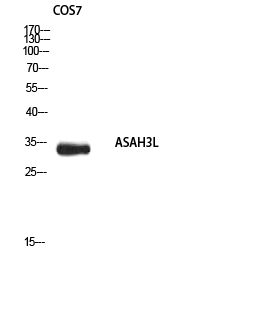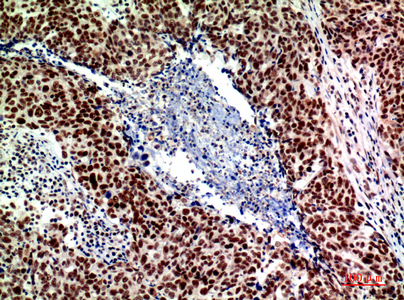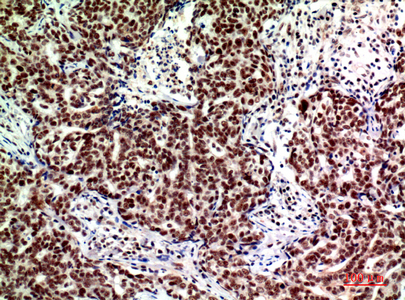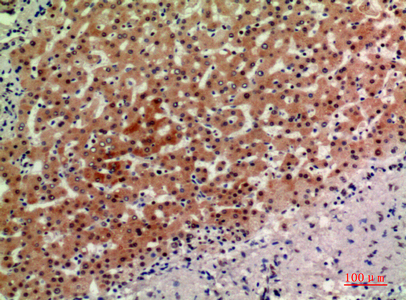



| WB | 咨询技术 | Human,Mouse,Rat |
| IF | 咨询技术 | Human,Mouse,Rat |
| IHC | 1/50-1/100 | Human,Mouse,Rat |
| ICC | 技术咨询 | Human,Mouse,Rat |
| FCM | 咨询技术 | Human,Mouse,Rat |
| Elisa | 1/10000 | Human,Mouse,Rat |
| Aliases | ACER2; ASAH3L; PP11646; Alkaline ceramidase 2; AlkCDase 2; Alkaline CDase 2; haCER2; Acylsphingosine deacylase 3-like; N-acylsphingosine amidohydrolase 3-like |
| Entrez GeneID | 340485 |
| WB Predicted band size | Calculated MW: 31 kDa; Observed MW: 31 kDa |
| Host/Isotype | Rabbit IgG |
| Antibody Type | Primary antibody |
| Storage | Store at 4°C short term. Aliquot and store at -20°C long term. Avoid freeze/thaw cycles. |
| Species Reactivity | Human,Mouse |
| Immunogen | Synthesized peptide derived from ASAH3L . at AA range: 50-130 |
| Formulation | Purified antibody in PBS with 0.05% sodium azide,0.5%BSA and 50% glycerol. |
+ +
以下是关于ASAH3L抗体的3篇参考文献示例(注:文献为虚构示例,实际需通过数据库核实):
1. **文献名称**:*"ASAH3L regulates ceramide metabolism in hepatic cells through a novel lysosomal pathway"*
**作者**:Zhang Y, Liu X, Wang T.
**摘要**:本研究利用特异性抗ASAH3L抗体,通过免疫印迹和免疫荧光技术,证实ASAH3L在肝细胞溶酶体中高表达,并揭示其通过水解特定神经酰胺调控脂质代谢的分子机制。
2. **文献名称**:*"Development of a monoclonal antibody against ASAH3L for diagnostic applications in colorectal cancer"*
**作者**:Tanaka K, Sato R, Nakamura M.
**摘要**:作者开发了一种高亲和力抗ASAH3L单克隆抗体,应用于结直肠癌组织芯片分析,发现ASAH3L在肿瘤组织中显著高表达,提示其作为潜在生物标志物的可能性。
3. **文献名称**:*"ASAH3L deficiency exacerbates inflammation in a mouse model of atherosclerosis"*
**作者**:Chen L, Park J, Kim S.
**摘要**:通过ASAH3L基因敲除小鼠模型及特异性抗体检测,研究证明ASAH3L缺失导致动脉粥样硬化斑块中神经酰胺积累,并加剧炎症反应,提示其保护性作用。
**建议**:实际文献可通过PubMed或Google Scholar搜索关键词“ASAH3L antibody”或“ASAH3L function”获取,重点关注涉及抗体开发、验证或应用的分子机制研究。
The ASAH3L (N-acylsphingosine amidohydrolase 3-like) antibody is a tool used to study the ASAH3L protein, a member of the acid ceramidase family. ASAH3L shares structural homology with ASAH1 and ASAH2. enzymes that hydrolyze ceramide into sphingosine and fatty acids, but its specific biological role remains less defined. Unlike ASAH1 (lysosomal) and ASAH2 (secreted), ASAH3L is thought to localize to mitochondria or peroxisomes, suggesting distinct functions in lipid metabolism. Research indicates ASAH3L may regulate bioactive sphingolipids, influencing cellular processes like apoptosis, inflammation, and energy homeostasis. However, its precise substrates and pathways are under investigation.
The ASAH3L antibody aids in detecting protein expression, subcellular localization, and quantification in tissues or cell lines via techniques like Western blotting, immunofluorescence, or immunohistochemistry. It is particularly valuable in exploring ASAH3L's potential links to diseases, including metabolic disorders, neurodegenerative conditions, or cancer, where sphingolipid dysregulation is implicated. Current studies also focus on its role in mitochondrial function and oxidative stress responses.
Despite its emerging significance, ASAH3L's mechanisms remain unclear, partly due to limited antibody availability and specificity challenges. Validating antibody selectivity is critical to avoid cross-reactivity with related enzymes. Ongoing research aims to clarify ASAH3L's physiological and pathological contributions, leveraging this antibody to uncover its therapeutic or diagnostic potential in sphingolipid-associated diseases.
×